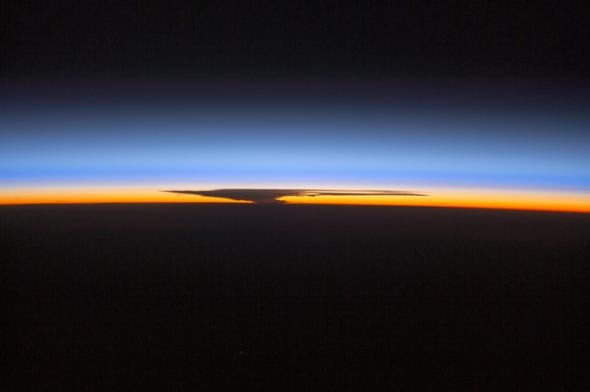My family is traditional and requires everyone at the table on Thanksgiving to say what they’re thankful for. I always struggle with what to say. But if you’re an astronaut—besides getting back down to the ground safely—I imagine there’s a pretty common answer: the atmosphere.
On a day that’s supposed to be all about the big-picture ideals of peace and unity, I think we should look to the skies. No one understands gratitude better than an astronaut.
Earth’s atmosphere is what makes life possible as we know it. When viewed from orbit, it’s impossibly thin—especially when compared to the vast nothingness of outer space.
So, the photo above caught my eye earlier this week when it was featured as NASA’s photo of the day. It’s a powerful reminder that something as mighty as a summer thunderstorm is itself just a blip in the thin envelope of molecules that protects us and makes all this possible. From NASA:
Astronauts often comment on the thinness of the Earth’s life-supporting envelope, and how it suggests the fragility of our planetary ecosystem. They also note that the number of atmospheric layers they can detect with their eyes is much greater than what their photographs show.
One of the earliest known implications of space travel noticed by returned astronauts is what author Frank White has called the “overview effect.” Again, from NASA:
“For the first time in my life, I saw the horizon as a curved line. It was accentuated by a thin seam of dark blue light: the atmosphere,” said Ulf Merbold, a German astronaut who flew on Space Shuttle Columbia in 1983. “This was not the ‘ocean’ of air I had been told it was. … I was terrified by its fragile appearance.”
White has made the overview effect a life philosophy. He’s helped found the Overview Institute, an organization dedicated to immersive space-related art and media that will allow the rest of us Earth-bound landlubbers to experience the transcendent insights that, until now, has been possibly only by space travel.
While on the space station this July, German astronaut Alex Gerst noticed lights moving quickly down below. He snapped a photo—and soon realized he was watching rocket attacks over Gaza and Israel. He later wrote this on his European Space Agency blog:
Some things that on Earth we see in the news every day and thus almost tend to accept as a “given”, appear very different from our perspective. We do not see any borders from space. We just see a unique planet with a thin, fragile atmosphere, suspended in a vast and hostile darkness. From up here it is crystal clear that on Earth we are one humanity.
If, just for a moment, we can understand how improbable our existence is and remember that we’re all dependent on one another, like it or not, then I believe anything is possible.
If you’re stuck in an airport this Thanksgiving, or if you find yourself needing a little inspiration during a break from the in-laws, take a moment to peruse this archive of full-disk images of Earth taken by astronauts or watch this 20-minute film on the overview effect featuring reflections from five astronauts.
